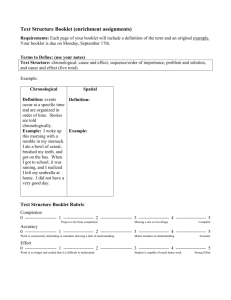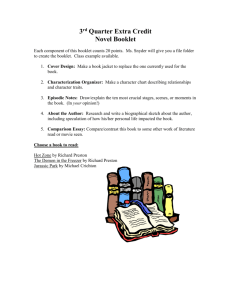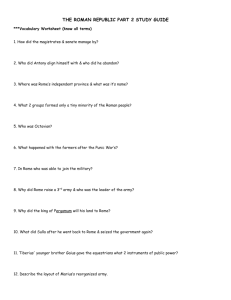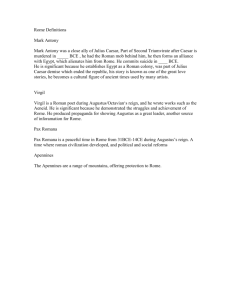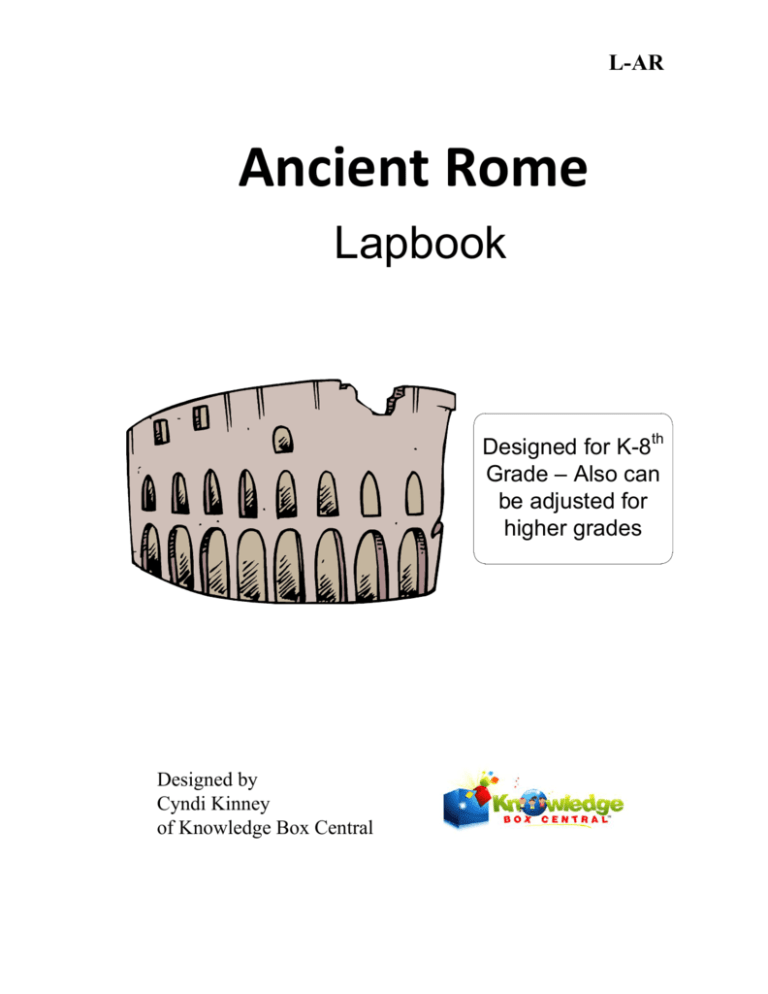
L-AR
Ancient Rome
Lapbook
Designed for K-8th
Grade – Also can
be adjusted for
higher grades
Designed by
Cyndi Kinney
of Knowledge Box Central
Ancient Rome Lapbook
Copyright © 2010 Knowledge Box Central
www.KnowledgeBoxCentral.com
ISBN #
Ebook:
978-1-61625-050-8
CD:
978-1-61625-051-5
Printed:
978-1-61625-052-2
Assembled: 978-1-61625-053-9
Publisher: Knowledge Box Central
Http://www.knowledgeboxcentral.com
All rights reserved. No part of this publication may be reproduced, stored in a
retrieval system or transmitted in any form by any means, electronic, mechanical,
photocopy, recording or otherwise, without the prior permission of the publisher,
except as provided by USA copyright law.
The purchaser of the eBook or CD is licensed to copy this information for use with
the immediate family members only. If you are interested in copying for a larger
group, please contact the publisher.
Pre-printed format is not to be copied and is consumable. It is designed for one student only.
All information and graphics within this product are originals or have been used with
permission from its owners, and credit has been given when appropriate. These include, but
are not limited to the following: www.iclipart.com, and Art Explosion Clipart.
This book is dedicated to my amazing family. Thank you to my wonderful
husband, Scott, who ate a lot of leftovers, listened to a lot of whining
(from me!), and sent lots of positive energy my way. Thank you to my
daughter, Shelby, who truly inspired me through her love for learning.
Thank you to my parents, Judy and Billy Trout, who taught me to trust in
my abilities and to never give up.
How do I get started?
First, you will want to gather your supplies. Depending on which format you purchased
from us, you will need different supplies. So, take what applies, and skip over the rest.
*** Printing:
*Print instructions and study guide on white copy paper.
*Print the booklet templates on 24# colored paper or 110# cardstock.
For some booklets, we have suggested specific colors or cardstock.
You may choose to use those suggested colors, or you may choose
to print on any color that you like.
*** Assembly:
*Folders: We use colored file folders, which can be
found at Walmart, Sam’s, Office Depot, Costco, etc. You will need between
2 and 4 file folders, depending on which product you have purchased.
You may use manilla folders if you prefer, but we have found that
children respond better with the brightly colored folders. Don’t worry
about the tabs….they aren’t important. If you prefer, you can purchase
the assembled lapbook bases from our website.
*Glue: For the folder assembly, we use hot glue. For booklet
assembly, we use glue sticks and sometimes hot glue, depending on
the specific booklet. We have found that bottle glue stays wet for too
long, so it’s not a great choice for lapbooking.
*Other Supplies: Of course, you will need scissors. Many
booklets require additional supplies. Some of these include metal
brad fasteners, paper clips, ribbon, yarn, staples, hole puncher, etc.
You may want to add decorations of your own, including stickers, buttons,
coloring pages, cut-out clipart, etc. The most important thing
is to use your imagination! Make it your own!!
Ok. I’ve gathered the supplies. Now how do I use this
product?
Inside, you will find several sections. They are as follows:
1. Lapbook Assembly Guide: This section gives instructions and diagrams
will tell the student exactly how to assemble the lapbook base and where to
glue each booklet into the base. Depending on the student’s age, he or she may
need assistance with this process, especially if you choose to allow the student
to use hot glue.
2. Student Instruction Guide: This section is written directly to the student,
in language that he or she can understand. However, depending on the age of
the child, there may be some parent/teacher assistance needed. This section
will also tell the student exactly what should be written inside each booklet as
he or she comes to it during the study, as well as telling the student which
folder each booklet will be glued into.
4. Booklet Templates: This section includes ALL of the templates for the
booklets. These have been printed on colors that will help to improve retention
of the information presented, according to scientific research on color
psychology.
5. Teacher/Study Guide: This section is a great resource for the parent/
teacher. In this section, you will find the page number where each answer may
be found in the book. You will also find suggestions of extra activities that you
may want to use with your student.
You will need 4 folders of any color. Take each one and fold both sides toward the original
middle fold and make firm creases on these folds (Figure 1). Then glue (and staple if
needed) the backs of the small flaps together (Figure 2).
Figure 1
Figure 2
This is the “Layout” for your lapbook. The shapes are not exact on the layout, but you will
get the idea of where each booklet should go inside your lapbook.
Inside of 1st Folder:
Romulus &
Remus
Pets
History
Fact
Map
Art
Flora &
Fauna
Inside of 2nd Folder:
Calendar
Roman Soldier
Label
Circus
Maximus
Marriage
Slavery
Life of
Soldier
Adornment
Clothing
Pompeii
Inside of 3rd Folder:
Toys
Coliseum
Other
Important
Events
Homes
Fact
Vocabulary
School
Music
Food
Baths
Inside of 4th folder:
Gods &
Goddesses
Who’s Who
Vocabulary
Fact
Fact
Other
Important
People
Below you will find pictures of a completed lapbook. This should help
in figuring out how to assemble the booklets and then how to put it all
together!
Also, there is a page of close-up pictures of some of the booklets that
may be a little more confusing to assemble. These pictures should
help.
Folder #1
Folder #2
Folder #3
Folder #4
Booklet #3
Booklet #4
Booklet #21
Booklet #27
Booklet #23
Respected American Women
Lapbook
Student Instruction Guide
What do I put on the outside of
my lapbooks?
The cover of your lapbook has purposely been left blank so that you may decorate it in
any style you choose. Here are a few suggestions:
1. Go to www.enchantedlearning.com, and print out pictures of people, places, events.
2. Draw a picture of some of the people of places you learned about during your study.
3. Use your search engine to find coloring pages or clip art that tell about your study.
4. Use stickers to decorate.
5. Go to www.makingfriends.com, and print out a paper doll.
6. Go to http://www.dltk-kids.com/world/index.htm and print out coloring sheets or
crafts to use on the cover or various places within your lapbook.
7. In your best handwriting, write the names of some of the people that you studied all
over the outside of your lapbook.
8. Print out maps from Ancient Rome, and glue them on your cover.
Ancient Rome Lapbook
Student Instruction Guide
Booklet #1
*Booklet Title: Ancient Rome Map Booklet
*Student Instructions: A map of Rome today looks very different than the ones from
Ancient Rome. Go to this website link to view Ancient Rome maps: http://
www.socialstudiesforkids.com/subjects/ancientromemaps.htm
Choose a map for this booklet, and print it out.
*Completed booklet will be glued into Folder #1 (See Layout)
**Assembly Instructions: Cut out along the outer black line edges. Then glue to a larger
piece of paper of a different color. Trim around the edges, creating a small border. Glue
your map in the center.
Booklet #2
*Booklet Title: Romulus & Remus Booklet
*Student Instructions: Have you ever heard of Romulus and Remus? Their legend is
where our study begins. Tell what you have learned about them here.
*Completed booklet will be glued into Folder #1 (See Layout)
**Assembly Instructions: Cut out along the outer black line edges of each page. Stack
the pages so that the title is on top. Along the left side, punch 2 holes and secure with
metal brad fasteners or ribbon. You may choose to just staple.
Booklet #3
*Booklet Title: Ancient Roman History Booklet
PICTURE on page 9
*Student Instructions: After studying about Ancient Roman history, write about each of
the topics on the tabs of this booklet.
*Completed booklet will be glued into Folder #1 (See Layout)
**Assembly Instructions: Cut out along the outer black line edges of each page. Stack
the pages so that the title is on top and the tabs are in order. Along the left side, punch 2
holes and secure with metal brad fasteners or ribbon. You may choose to just staple
Booklet #4
*Booklet Title: Gods & Goddesses Booklet
PICTURE on page 9
*Student Instructions: The Ancient Romans believed that different gods and goddesses
controlled most aspects of the world. Tell about each of these gods and goddesses in this
booklet.
*Completed booklet will be glued into Folder #4 (See Layout)
**Assembly Instructions: Cut out along the outer black line edges of each page. Stack
the pages so that the title is on top. Along the left side, punch 2 holes and secure with
metal brad fasteners or ribbon. You may choose to just staple
Booklet #5
*Booklet Title: Coliseum Booklet
*Student Instructions: Inside this booklet, tell about the amazing structure called The
Coliseum.
*Completed booklet will be glued into Folder #3 (See Layout)
**Assembly Instructions: Cut out along the outer black line edges of the booklet. Fold
along the center line so that the title is on the front.
Map of Ancient Rome
Booklet #1
Romulus
and
Remus
Booklet #2
Ancient Roman
History
First People
Booklet #3
Punic Wars
The Fall of
Greece
Booklet #3
Civil War
Fall of
Rome
Booklet #3
Ancient Rome
Lapbook
Teacher’s/Study Guide
Following is information taken from various sources WITH permission. Most information
needed to complete your booklets is included in this section. You may need to do some
research on your own for some questions. There are many extra facts about this time period,
in case you want to take your study a little further. Thank you to Michelle Habrych for
revising this study guide for me!
Ancient Rome
Adventure, betrayal, romance, war, rebellion—Ancient Rome has a story fit for a Hollywood
movie. There was a time it was considered one of the most important cities in the world. To find out how
it began, start with the legend of Romulus and Remus.
It is tradition that the city of Rome was formed by twin brothers Romulus and Remus. Their
parents were Mars, the Roman god of war, and a Latin princess. Her father, the king, feared these boys
would try to take his throne. So he took the infants, placed them in a basket and abandoned it by the banks
of the Tiber River. The abandoned babies were discovered by a female wolf, which nursed them with her
own milk. Later, some shepherds rescued the boys and raised them as their own children.
Romulus and Remus grew up and decided to build a city in the place they were born. The city
would be ruled by both of them, each from his own hill. However, the brothers soon fought about who got
more of the city to rule. Romulus ended up killing Remus and ruling the city on the hill of Palatine,
naming it Rome after himself.
It is unknown whether this legend is based on fact, but scholars agree that the city of Rome began
as a settlement of Greek and Latin tribes around 753 B.C. in the southern portion of Italy. This capital city
grew from a collection of sheepherders’ huts in 8th Century B.C. to an enormous city in A.D. 1st Century.
The Etruscans inhabited the northern part of Italy and were the first people to plan Rome’s city streets and
build its sewers. Rome was divided into four regions in early 5th Century B.C.: Suburana, Esquiline,
Collina and Palatine. The center of these four regions was a meeting place for peasants to exchange goods
and became known as the forum. Markets, government buildings and temples surrounded this open space.
The Latin tribes did not want to be ruled by Etruscan kings and fought against them in 509 B.C.
After gaining power, the Latins changed their government. Instead of a king, they elected two consuls,
men who would rule for one year. These men were often generals. Growth in Rome was completely
unorganized for the next 200 years.
The villagers continued to fight and expand their territory, conquering the tribes in central Italy.
Finally, the army fought the Greeks in Southern Italy, who had hired Pyrrhus of Epirus to lead the Greek
army. He defeated the Romans twice, but he lost so many men that he had to return to Epirus. By 250
B.C., the Romans ruled all of Italy. The conquered people became Roman citizens.
War continued for the Romans with a fight against the Carthaginians of North Africa. Carthage
tried to conquer Sicily’s Greek cities, so the Greeks appealed to the Romans for help. This power struggle
became a series of battles named the Punic Wars, the term Punic coming from the Latin word Punicus (or
Poenicus), meaning "Carthaginian."
The Romans built a fleet of ships to fight the Carthaginians on land and on the sea in the First
Punic War (264-241 B.C.). Though the Carthaginians were better sea fighters, the Romans won, causing
their enemies to give up Sicily and move to Spain to set up a new base. Led by Hamilcar Barca, the
Carthaginians collected troops to fight the Romans. However, Barca was killed in fight with a Spanish
tribe before he could direct the Carthaginians in battle.
In the Second Punic War (218-201 BC), Barca’s son, Hannibal, led an army against Rome,
carrying out his father’s plans. Rome had many enemies at this time, so Hannibal was able to gather a
huge army against Rome. He began the march against Rome in 218 B.C. with 90,000 infantry, 12,000
cavalry and 40 elephants, crossing Gaul and climbing the Alps from Spain.
Just half of the army actually reached Italy, so Hannibal collected more troops there. Several
Roman armies were sent to fight against the Carthaginians, but Hannibal’s troops defeated them all.
Rome’s strategy to cut off Hannibal’s food supply kept the Carthaginians from reaching Rome. Then the
Romans sent their biggest army ever to fight Hannibal’s men at a river. The Carthaginians were not
fooled. Hannibal let the army reach the center of the fight before closing in on them and slaughtering
them. At this Battle of Cannae, the Carthaginians lost only 8,000 men compared to Rome’s 70,000
casualties.
After spending 15 years in Italy, Hannibal and his army finally had to return to Carthage to defend
against an attack by the Roman army. The Carthaginians were defeated when the Romans completely
destroyed Carthage, killing many citizens. This ended the Second Punic War.
Finally, the entire conflict was resolved in the Third Punic War (149-146 B.C.) when Scipio
Africanus led Rome’s army and defeated Hannibal. Spain became part of the Roman Empire. Carthage
was forced to send money to Rome annually. An adopted grandson of Scipio Africanus, who had the
same name, attacked Carthage with a large army, tearing down the city and burning it. The people of
Carthage were sold as slaves or killed as a result.
In defeat, Hannibal ran for his life. He hid in Tyre, then Ephesus, as he was followed by the
Romans. Hannibal was able to hide with the King of Bithynia for a bit of time before the Romans
demanded the king surrender Hannibal. The former leader of the Carthaginians carried poison in a ring he
wore on his finger and killed himself rather than surrender to the Romans. At his death, Hannibal was 64.
Though the Romans had become the most powerful people in the Mediterranean, they continued
to fight those around them. To prove their superiority to the Greeks, the Romans sent General Flamininus
to fight the Greeks in Macedonia, their most powerful city-state. Rome won the fight but Flamininus was
easy on the Greeks after the victory.
After a few years, another Roman army was sent to fight, commanded by General Mumius. This
victory over the city of Corinth was much different from Flamininus’ earlier victory in Macedonia. The
Roman army killed all the Greek men in the city and sold the women and children into slavery. The city
was sacked. Much artwork was carried back to Rome and given to a few rich citizens.
The Romans had a problem, though. The armies were a long way from home, sent into the
frontiers to keep farmers and herders from fighting. Soldiers felt loyal to the generals because they had
direct contact with them, unlike the consuls who were far away in Rome.
This division of loyalty would eventually lead to civil war. By 100 B.C., Roman officials had
become greedy and corrupt, some demanding huge taxes from the people. Slaves revolted during this time
as well. In 73 B.C., Spartacus gathered an army of 90,000 fellow slaves at Mount Vesuvius. He fought the
Roman army until his death in 71 B.C.
Some powerful Roman generals attempted to take power from these officials. One of these men
was Pompey, who had been sent to conquer western Asia with his army. The Roman senate feared
Pompey and wanted to take away some of his powers. Two other powerful generals at this time were
Crassus and Julius Caesar.
Caesar was the governor of Gaul. He had spies in Rome, looking for an opportune time to march
into the city and take over. Caesar had been ordered to stay in Gaul by the Roman senate, but he marched
anyway.
Pompey was surprised and did not like Caesar’s grab for power, so he gathered an army of his
own. When the two armies met in Northern Greece, Caesar was the winner. He then traveled and fought
battles in western Asia, North Africa and Spain. Pompey escaped to Egypt where he was murdered.
While in North Africa, Caesar met the rulers of Egypt, Cleopatra and her brother Ptolemy XIII.
Ptolemy feared his sister because she was so smart, so he sent her out of the country. When Julius Caesar
heard this, he sent for her. Cleopatra wrapped herself in a blanket and had herself delivered to him; they
soon fell in love.
Caesar returned victoriously to Rome and became its sole ruler in 45 B.C. He brought change to
the government and planned improvements for Rome. He developed a detailed plan for growth, but would
not get the opportunity to carry it out himself. The senators did not like the changes or Caesar. Brutus and
Cassius, two senators, plotted to kill Caesar. They succeeded on March 15 (also known as ―the Ides of
March.‖), 44 B.C. Caesar was 58 years old when he was stabbed 27 times right on the floor of the senate.
Another struggle for power ensued. Caesar had named his great-nephew Gaius Octavius Thurinus
(referred to as ―Octavian‖ by modern historians) as his heir in his will. However, the Roman people
looked to Caesar’s friend Marc Antony, who had been a consul with Caesar, as a leader. Octavian was
just a teenager when he came into power. So, the two ruled together.
It wasn’t long before Caesar’s conspirators, Brutus and Cassius, were unhappy with the power that
Antony and Octavian had over the people and decided to raise an army to fight the pair in Greece. The
Roman rulers also raised an army, and the two fought in Northern Greece, where Brutus and Cassius lost,
making Antony and Octavian the masters of the Roman Empire.
Antony decided to travel through parts of the Empire, including the Near East and Egypt. It was
there he, too, fell in love with the Egyptian ruler Cleopatra. During this time, both men decided they
wanted sole control of the Roman Empire, no longer content to rule together.
In a sea battle off the coast of southwest Greece, Octavian defeated Antony. Rather than face
defeat, Antony stabbed himself to death and Cleopatra wrapped a poisonous snake around her arm. This
victory made Octavian the first emperor of the Roman Empire. He took the name Augustus and was
followed by members of his family.
To expand the Empire, Augustus (formerly Octavian) built up the army and conquered
surrounding territories. He is considered a smart politician because he lived in a simple house and did not
spend much money on parties. He had a good relationship with the senate. Augustus carried out Julius
Caesar’s detailed plan for growth, along with the assistance of his son-in-law Agrippa. The city of Rome
was divided into 14 districts. Augustus ruled alone from 27 B.C. until his death in A.D. 14. His rule was
the beginning of Pax Romana, or ―Roman Peace‖ in Latin. It was a peaceful period in the Empire’s
history and lasted 200 years.
A large fire destroyed Rome in A.D. 64, and the city had to be rebuilt from scratch. Hadrian
became emperor in A.D. 117. He strengthened the Empire’s frontiers and built a stone wall across
northern Britain to protect against barbarian tribes. Also during this time, the Roman army in Judea
stopped a revolt led by the Jews, and thousands were killed. By the 2nd Century, more than 1.2 million
people lived in the capital of the Roman Empire. The large Roman Empire now contained the entire
Mediterranean world, including most of Europe and parts of East and North Africa.

